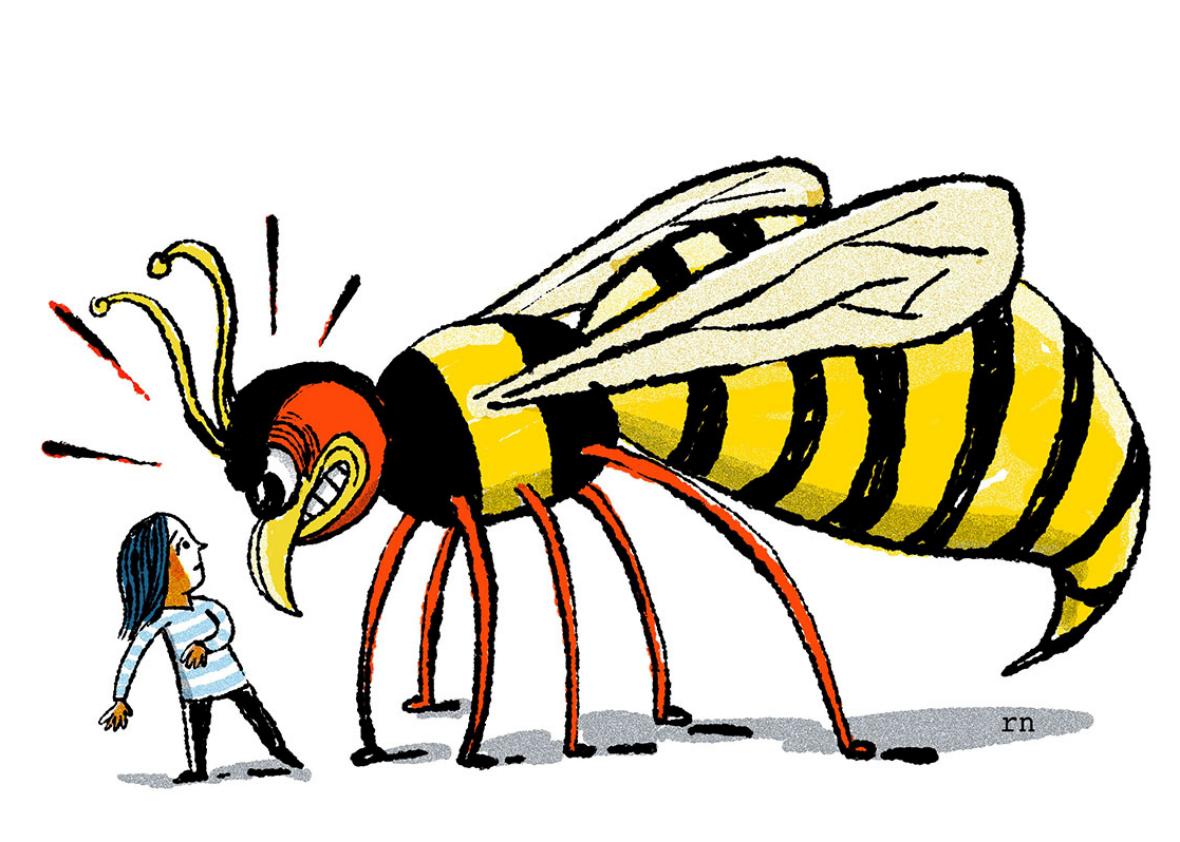I used to think of hornets and yellow jackets as the jerks of the animal kingdom. These stinging, flying wasps ruin countless picnics with their aggressive appetite for candy, fruit, and soda. They sting thousands of Americans every year, killing up to 100 people through anaphylactic shock. And one of them stung me three times on the face as I walked out of a campground bathroom one July. What an asshole, right?
Not according to entomologists. Ten years after that fly-by stinging, I’ve calmed down enough to look into this pressing summer question: What’s up with hornets and yellow jackets that makes them so vicious in late summer?
It turns out that, like many humans’ bad behavior, the wasps’ jerkiness can be traced back to their families.
Many of the hornet and yellow jacket species that sting us are social insects. Unlike solitary insects such as carpenter bees, social insects live in colonies, where hordes of sterile female workers tend to their younger sisters and fertile mother. As living incarnations of Ayn Rand’s nightmares, these social insects do everything for the good of the colony.
But unlike human socialists (and unlike distantly related honeybees), hornets and yellow jackets must start their colonies from scratch every year. In spring, a young queen emerges from winter dormancy and builds a new nest by herself out of wood pulp and spit. Her lonely labor continues until she’s raised her first brood of worker daughters, which dutifully take over caring for the next rounds of eggs, larvae, and pupae. And there are many next rounds: A colony of hornets or yellow jackets may grow to 1,000 workers, says entomologist Donald Lewis of Iowa State University —although you wouldn’t know it for most of the summer.
The reason we don’t notice them much then comes down to all those squirming, hungry larvae. These soon-to-be workers need lots of protein for their growing bodies—but not just because they’re getting bigger. As if toddlerhood and adolescence aren’t hard enough, these newly hatched larvae must undergo full-body metamorphoses, first into pupae and then into flying adults. During these transformations, the maturing hornets or yellow jackets must digest their old body and build the new one from scratch, using only the raw nutrients they get from their diet.
To get protein for their metamorphosing sisters, species like the bald-faced hornet and the German yellow jacket hunt for caterpillars, flies, crickets, and other crop pests. Western yellow jackets scavenge protein from dead insects and carrion. These bits of dead bugs and roadkill are then chewed into a delicious, locally sourced paste for the insatiable young. Thanks to these youthful appetites, adult workers are so busy killing insects for the larvae they barely have time to snatch a quick sip of nectar or a sugary meal for themselves—meaning they rarely bother your pie or juice most of summer. But these harried workers are not too worn out to fight if they must.
Until midsummer, most human and wasp encounters happen because people disturb the colony’s nest. Bald-faced hornets like making their nests in trees and under the eaves of houses while paper wasps favor exposed beams. Yellow jackets can be particularly troublesome: They build their homes inside the walls of our homes, as well as holes in the ground—often where people walk and mow grass. “I’ve personally disturbed their nests” while doing field research, says entomologist Seán Brady of Smithsonian’s National Museum of Natural History. Which required a lot of running away, he continues, because “they’ll follow you a lot longer than honeybees.” They’ll also sting you a lot more than honeybees, thanks to their smooth, venomous stinger, which doesn’t get stuck in your tender flesh after one thrust like the bee’s barbed stinger.
But things change for these communal, defense-minded wasps when the queen lays her final broods, which mature into fertile kings and queens that fly away to eventually form their own colonies. Once those fertile siblings leave the nest in late summer and early fall, their left-behind sisters no longer must spend time defending the colony and hunting for food for the young. They only need to worry about defending themselves and eating what they want—which is why August and September have the most yellow jacket stings. And as adults, they just want sugary foods that give them a quick boost of energy. Sugary foods like ice cream, soda—and fallen fruit that is fermenting.
“Yes,” says Lewis, “fermenting plant sap will cause them to be inebriated.” Although we really shouldn’t begrudge them a drink. These workers have devoted their brief lives to serving queen and colony, and they will all die of cold and old age by Thanksgiving. Only the freshly mated queens will survive the winter huddled behind house siding and beneath rotting logs, waiting until spring returns to start the whole cycle anew.
If you can’t wait for the icy hand of death to squash these stinging picnic thieves, here’s some advice on how to avoid their sharp, venomous ends. Brady recommends keeping an eye out for their nests, which are often in inconspicuous places like holes in the yard or under the eaves of houses. Lewis suggests avoiding flowery-smelling perfumes and not waving your arms frantically when you see one. And the Centers for Disease Control and Prevention recommends keeping food and garbage in tightly sealed containers, as well as being prepared to flee if multiple insects start attacking.
While you’re fleeing, bear in mind that this is only temporary. Unlike us road-raging, Twitter-trolling, lion-shooting humans, hornets and yellow jackets are only assholes for part of the year. But I understand that can be hard to remember—especially if one of them just stung your cheek.
